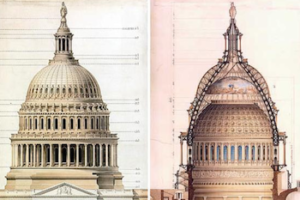
*On this date in 1863, "Freedom," the statue on top of the dome of the U.S. Capitol, was permanently installed.
The Man responsible for this architectural feat was Philip Reed, a Black slave. He worked at the Bladensburg (Maryland) Foundry, where he supervised the bronze casting of the statue. The story of the nation's capital building began in 1856. At that time, Thomas Crawford completed the full-size plaster model of Freedom at his studio in Rome, Italy. When cast in bronze, it was intended to stand atop the Dome of the United States Capitol.
In April 1858, the model left Rome aboard Emily Taylor's ship in six crates. While crossing the Atlantic, the boat sprung a leak that worsened. The Taylor made it to Bermuda and was condemned. Freedom was transferred to another ship for the Mills Foundry in Maryland trip. The federal government had awarded the Mills Foundry a contract to cast the plaster model in bronze, and the work began in May 1860. Amid the casting, the Foundry Foreman went on strike for higher wages, believing he was the only person qualified to see the casting to its completion. Clark Mills, the foundry owner, turned to the slave, who worked alongside the foreman and put him in charge of the final casting.
This was Philip Reed. Reed supervised the remaining casting of the statue in five sections, each weighing over a ton. The tons of Freedom were moved by wagons from Bladensburg, Maryland, to Washington. Reed and other slaves put the Statue of Freedom together on the grounds of the Capitol in a month during the spring of 1863. On this date, in 1863, the Statue of Freedom was hoisted to the top of the Capitol Dome with a grand celebration and a 35-gun Salute.

Philip Reid was one of the last of hundreds of slaves involved in building the Capitol between 1790 and 1863. The slaves worked in the quarries of Virginia, digging and transporting the stone that became the beautiful building that stands today. At the building site, the slaves performed the truly backbreaking work required to place the cut stones on the walls of the Capitol building. They dug trenches and ditches, hauled lumber, and performed other tasks requiring great strength and stamina.
Half the workforce at the Capitol building site were slaves. Shortly after he completed this mission, the District of Columbia issued its Emancipation Proclamation abolishing slavery within the Capital City, and Philip Reed was no longer a slave.